In Greek there is the word "scolios", which translates as "crooked".In this word, doctors indicate the curvature of the spine.Moreover, not the entire curvature, namely the lateral deviation of the vertical axis of the spine.The fact is that our spine is usually not completely uniform.The turns, which are available in front and back (lordose and kyphosis), protect our spine from excessive loads, while keeping the body in a certain position when moving and wearing weights.The negative processes in our body develop only when these kyphoses and lordose are expressed above the permissible norm.
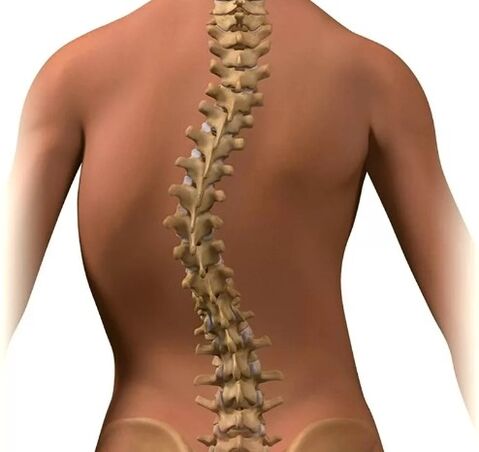
The main problems
However, even a small degree of lateral turns (scoliosis) of the spine is always a pathology.And the question is not just a cosmetic defect.Although the characteristic repulsive species with a pronounced or progressive scoliosis is always a tragedy for a person who seeks to live with a high quality full life.This is especially true for young boys and girls.In fact, it is in the childhood and youth (up to 15 - 16 years) that a significant portion of scoliosis is diagnosed.
The main problem is that due to a change in the configuration and volume of the breast with a pronounced lateral curvature, the internal organs always suffer (heart, lungs, stomach, liver, intestines, large vessels).In men, tolerance to exercise reduces women have problems with conception, wearing pregnancy and childbirth.In addition, very often the lateral deformity of the spine is only the superficial part of the iceberg, which is a sign of a much more serious pathology - tumor, tuberculosis, endocrine disorders.
Reasons
So why is the spine deformed?Before answering the question, you need to solve the types of scoliosis.At its base, scoliosis can be structural and non -structural.Structural scoliosis develops due to the anatomical changes in the structure of the bone tissue of the vertebrae, as well as the muscles, nerves and ligamental apparatus located nearby.Such curves can be acquired and congenital, and about a quarter of all diagnosed scoliosis represent the latter.
Among the main reasons for the development of structural scoliosis, they distinguish:
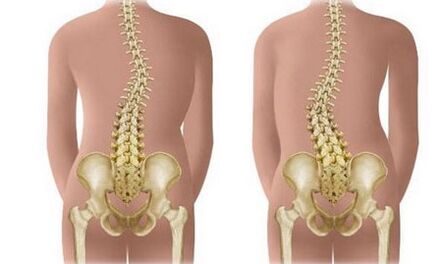
- Intrauterine development masts leading to dysplastic disorders of one or more vertebrae
- Congenital breast development abnormalities - lack of ribs, additional ribs
- Congenital connective tissue pathology - neurofibromatosis, Marfan syndrome
- Cerebral insufficiency due to cerebral paralysis of children (cerebral paralysis) leading to impaired innervation of certain parts of the spine
- Osteoporosis (bone dumbbell) of the spine in rickets, diseases of the parathyroid glands, lack of intake of calcium with food
- The osteomyelitis of the vertebrae
- Dystrophic changes in the cervical, thoracic and lumbar muscle
- Damage to the tuberculosis of the vertebrae
- Spine injuries
- Tumors of the spine.
Nonstructural scoliosis, as follows, are the lateral deviations of the spine axis with an unchanged structure of the vertebrae.As a rule, such scoliosis is most often acquired, except when the curvature has a compensatory nature with congenital anatomical defects in the pelvis or lower limbs.The reasons for such scoliosis are the most common:
- Pelvic injuries and lower limbs
- Congenital pelvic and lower limb defects
- Constant incorrect posture in students
- Diseases of the internal organs with asymmetrically expressed pain syndrome
- Muscular inflammation (myositis)
- Burns, soft tissue scars on one side.
In these cases, in order to eliminate the curvature of the spine, it is sufficient to cure the underlying disease and therefore many non -structural scoliosis is easily reversible.In this regard, some doctors tend not to consider non -structural deformities for scoliosis as a whole.
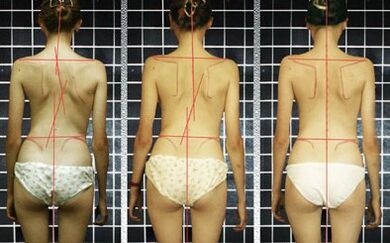
Recently, cases of scoliosis are developed for unclear causes have become more common.This is the so -called idiopathic scoliosis.This happens in the youth, during the period of rapid body growth.In addition, girls suffer from idiopathic scoliosis several times more than young men.Obviously, this is due to the relatively weak muscles on the back of the female, which is unable to close the spine in a complete muscle frame.An unbalanced diet with low calcium salts and a common passion for young people with carbonated drinks plays not the last role in the development of idiopathic scoliosis.As you know, carbon dioxide in bubbles and orthophosphoric acid in synthetic inclusions contribute to the extraction of calcium salts from the body.
Varieties and grades
Depending on the location, scoliosis may be cervical, thoracic, lumbar or mixed (cervical, lumbosacral).There may be one or more arcs on the curvature.In this regard, C-shaped scoliosis (with 1 arc), S-shape (with 2 arcs) and Z-shaped (with 3 arcs).Most likely the presence of 2 or 3 arches is compensatory.With C-shaped scoliosis, the axis of the spine deviates.In an attempt to compensate for this, the spine bends in the opposite direction.In this regard, scoliosis is divided into compensated and uncompensated.In a compensated spinal curvature, a vertical line, lowered from the 7th cervical vertebra, passes through the fold between the ass.
Spinal curvature is often combined.For example, in the thoracic area, in addition to the lateral curvature, there is a pathological kyphosis or just a hump.In these cases, speaking of thoracic kyphoscoliosis.In addition, with large degrees of scoliosis, in addition to the lateral displacement of the vertebrae, Thuria is noted.In a literal translation, it means twisting.In fact, with a lot of scoliosis, the spinal bone of the bones is twisted on the vertical axis.
Depending on the size of the angle of the arc of the curvature, 4 degrees scoliosis differ:
- 1 degree- The angle of the curvature does not exceed 10 degrees.Asymmetry by the eye is virtually not determined.Stoud, the uneven level of the shoulder girdle, pays attention.
- 2 degrees- The angle of the curvature is 11 to 25 degrees.To this extent, the vertebrae are already noted.The eye has asymmetry of the shoulder girdle and the pelvis, which is visible.Due to the pathological muscle tension, a muscle roll is formed in the lumbar region on the concave side and in the chest-with convex.
- 3 degrees- Wrtification is 26 to 50 degrees.Visible breast deformation - the western part of the inter -row spaces C in the concave side of the curvature and the convex with the convex.Weakening of the abdominal press, the formation of an inner hump.
- 4 degrees- The angle of curvature I exceeds 50 degrees.A cosmetic defect and all previous signs were expressed.Low tolerance of even small exercise.In addition to the musculoskeletal system, the internal organs suffer.
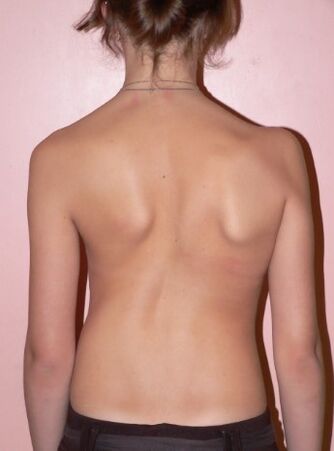
The angle may vary depending on the position of the body while distinguishing stable and unstable scoliosis.In unstable scoliosis, it decreases in a supine position when the spinal cord load decreases.With a stable spine curvature, this value remains unchanged.
Symptoms
Recently, orthopedists often use the term "scoliotic disease".And they show a complex of negative changes that occur in the body during the curvature of the spine.As a rule, scoliotic disease develops in childhood and adolescence, during the formation of the musculoskeletal system.Scoliosis is likely to progress at this time.
Obviously, intervertebral discs play an important role in increasing the angle of curvature.With the lateral displacement, the disc has an uneven pressure from the vertebrae bodies.On the concave side, this pressure is greater, with a convex -less.As a result, the disc is wearing even more than scoliosis, a pathological muscle tension (muscle roller) and the torsion of the vertebrae is created - all this leads to the appearance of disc hernias and to a more increasing increase in the angle of the curvature.
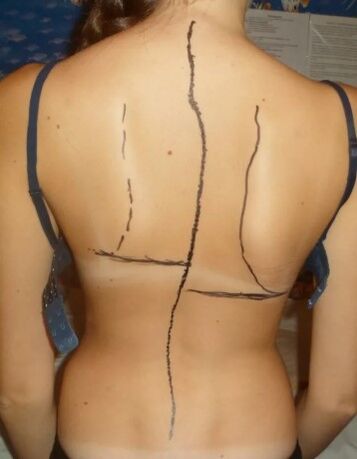
Along with the spine with a scoliotic disease, the breasts change in second place.The so -called humpback ribs are formed - from the convex side of the curvature, the interrebert spaces expand and the concave - on the contrary, they are sown.In grade 4 scoliosis, deformity of the breast is so pronounced that the lower ribs on the side of the curvature are in contact with the rowing of the iliac bone.
Due to the strong deformity of the breast, a complete excursion during breathing is difficult.As a result, the body with severe scoliosis does not receive the required amount of oxygen - the so -called chronic hypoxia develops with a violation of all metabolic processes in the body.The pathology is aggravated by the fact that the internal volume and shape of the thoracic cavity change.Therefore, blood circulation through the vessels is impaired, the lungs suffer, the shape of the heart changes, chronic cardiovascular failure develops.
Such changes occur in the abdominal organs for the lumbar and lumbosacral scoliosis.Stomach and intestine motors are reduced by subsequent enzymatic insufficiency of the digestive glands.All this only exacerbates metabolic disorders.These disorders often lead to a delayed sexual maturation of boys and girls.In addition, due to lumbar scoliosis, the pelvis is curved a second time.This creates problems for expectant mothers with pregnancy and childbirth.
Diagnostics
The diagnosis of scoliosis, especially large degrees, is generally not difficult.In order to detect deformity of the spine, visual examination is often sufficiently common.The visible curvature of the contours of the spine, the asymmetry of the shoulder girdle, the corners of the shoulder blades, the secondary curvature of the pelvis and the shortening of the lower limb on the side of the curvature are remarkable.
In the presence of at least one of these signs, radiography of the spine is indicated.X -ray determines the configuration, extent and location of the curvature.During the examination and radiological examination, it is possible to determine whether the scoliosis is compensated and stable.A new method for examining the magnetic resonance of the spine (MRI) has recently been distributed, during which a three -dimensional image of the spine can be obtained on the monitor screen.With significant curves, it is necessary to examine the work of the internal organs - to perform spirometry, electrocardiography and to perform ultrasound of the heart and internal organs.
Treatment
Scoliosis treatment can be performed both conservatively and immediately.Conservative methods include the treatment of drugs, massage, physiotherapy procedures and manual therapy.It should be borne in mind that the final formation of the spine ends with the age of 20 and after this age the correction of the curvature is almost impossible.With scoliosis of 1-2 degrees, efforts are aimed at achieving the initial, normal spinal configuration.With a pronounced scoliosis of the 3rd -4th degree, this is unattainable, the main thing here is to stabilize the spine and prevent the progression of scoliosis.

Medicines (chondroprotectors, vitamins, general strengthening drugs) in the treatment of scoliosis play only ancillary role.To strengthen the muscles, eliminate the muscle roll and even largely to stabilize the spine with the help of massage and manual therapy.The good effect is given from physiotherapy exercises.But here, with inadequate physical activity, the instability of the spine increases and scoliosis progresses.Therefore, a set of exercises for each patient is developed individually, taking into account the location and severity of the curvature.With a large degree of scoliosis, running, exercise for strength, jumps, outdoor games are contraindicated.
A very good result is adjusted from the position - it creates the optimal posture that contributes to the normalization of the posture.For this, special devices are used, orthopedic nurseries in which young patients spend a considerable part of their time.The ineffectiveness of conservative measures shows the progression of curvature, surgical treatment aimed at stabilizing the spine.The surgical correction is not shown at an early age, it is performed in adolescence when the spinal cord formation is almost completed.

















































